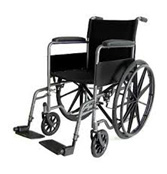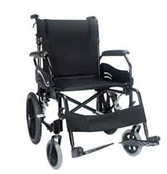How to choose a Wheelchair?
If you have a health condition that affects your walking, using a wheelchair may help you to continue to participate in activities that are an important part of your life, and let you go out and about with friends and family.
Wheelchairs vary from simple mechanical devices designed to be propelled by the user’s own strength or pushed from behind by a helper, to power-assisted wheelchairs with a range of features.
Wheelchairs generally have two main categories: manual wheelchairs, and powered or electric wheelchairs.
Manual Wheelchairs
Manual wheelchairs are usually most suitable for you if you;
- Require a wheelchair all or most of the time (indoors and/or outdoors) for mobility.
- Can walk – perhaps with a walking stick or walking frame – but are unable to cope with longer distances, so use of a manual wheelchair when you’re out and about would be helpful.
Apart from the look, there are many factors to consider before getting manual wheelchairs.
They are:
- Weight /Size
- Age: children, young adults, and older adults
- Self–propelling or transit
- Activities they want to do in their wheelchair: some people just what to sit, others want all of life’s activities without exceptions.
- Terrains
- Any other special needs
Weight/Size
Manual Wheelchairs comes in various size and weight capacity. It’s important that the wheelchair seat is the right size to provide comfort and support needed for prolonged use. Choosing the wrong size could result in back and leg pain, pressure sores, and other issues.
Age of user
Manual wheelchairs not only come in adult sizes, but they also have pediatric-sized wheelchairs for kids.
Self-Propelling or Transit Wheelchairs
You will need sufficient strength and movement in your arms to use a self-propelled wheelchair. If you aren’t able to manage this, you would be more suited to an attendant-propelled wheelchair, designed to be pushed from behind by a helper. It’s worth noting that most self-propelled wheelchairs will also have push handles for times when extra help may be needed.

Self-propelled wheelchairs have larger back wheels, each with an outer ‘push-rim’ that the user turns to control and propel the chair. These wheels make for a bulkier chair, which may be less easy to pack into the boot of a car. For this reason, if you are choosing a self-propelled chair, look for one with quick-release wheels, now commonly available.

Transit wheelchairs have smaller back wheels, so are often lighter and easier to transport around. They are also easier to navigate and control for the person pushing, although they can prove less willing than larger-wheeled chairs to mount obstacles such as curbs.
Terrains
The terrain is a major concern when considering a manual wheelchair. Maneuvering on a thick carpet, for example, will be slower than on tile or linoleum. Going uphill can be exhausting and downhill grades are dangerous for individuals who don’t have the strength needed to control their speed.
Other Special needs: Light Weight Manual Wheelchairs
Lighter manual wheelchairs are popular with those who have difficulty using a traditional manual wheelchair. Lightweight models usually weigh around 27 – 35 pounds and require less effort to move than a full-sized manual wheelchair.
Ultra-Light wheelchairs are also available, making them very maneuverable and easy to transport. Ultra-lightweight chairs come in strong high-tech composites and fibers and are a popular choice for those who are very active and strive for high performance.
Wheelchair accessories
Wheelchair manufacturers tend to offer greater flexibility than mobility scooter makers for customizing their products.
- Seats: often available in different lengths and widths, or a firmer seat can be custom-built. You can choose to add support or cushioning to give more postural support.
- Footplates and armrests: most wheelchairs have adjustable footplates and armrests to help achieve a good seating position.
- Backrest: the height is usually fixed.
- Headrest: purchasable as an optional extra.
- Storage bags: there are a few different styles of these available for use with wheelchairs, although they are generally not suitable for carrying large amounts of shopping.
- Protection against the cold or rain: a range of wheelchair-specific items are available, such as waterproofs in various styles and leg warmers that cover the lower half of the body like a half-length sleeping bag.
Why don’t you contact us at 5539 2141, we could help you in choosing the right one for you.



